Undoubtedly when I tell someone that I’m Puerto Rican the first thing out of their mouth is “You don’t look Puerto Rican.” I always act surprised and say “Oh? And what does a Puerto Rican look like?” (OK maybe not always. Sometimes I just grit my teeth and use my inside voice.)
In case you didn’t know, Puerto Ricans are the “Everything Bagel” of race. We’re descended from our island’s native Taino Indians, the Europeans that came over in search of gold and the African slaves they brought with them. We come in every color, shape and size. I have cousins with lovely cinnamon skin while I am jincha (slang for very light skinned). I have brown hair and brown eyes and my son has blonde hair and blue eyes. I am tall and lanky while my twin brother is stockier with a butt you could rest a cup on.
The reason the whole “You don’t look Puerto Rican” thing bothers me so much is that sometimes I don’t feel very Puerto Rican. My Spanish is a mess. I’ve only been to the island once in the last two decades. I can’t dance salsa or merengue.
If you’re like me and sometimes feel like a Boricua LITE I want to remind you that being Puerto Rican isn’t about how well we speak Spanish. It isn’t about how many times we’ve been to the island. And it certainly isn’t about how well we can move our feet and shake our ass.
Being Puerto Rican is in our blood. It’s something no one can take away from you. It’s a pride that swells inside you and makes you scream, “Boricua!” when you meet someone else with ties to the island.
So what does a Puerto Rican look like? As far as I know, the only trait all Puerto Ricans have in common, be they dark skinned, or light skinned, brown eyed or blue is if you cut us, we bleed amarillos.
Amarillos are the sweethearts of the Puerto Rican plate. They are plantains that have been ripened until their once green skins have morphed from yellow to all black. They are sliced and fried and served at breakfast, lunch and dinner. Their sweet tangy flesh pairs well with eggs, or rice and beans or as a substitute for pasta in a lasagna called pastelon.
Someone with an untrained eye will look at a batch of platanos maduros surrounded by fruit flies grimace and think, “Those need to be thrown out.” A Puerto Rican however, will take one look and their mouth will begin to water. We know that though that plantain looks like it’s been through hell and back, like it has nothing left to give, it is in fact a treasure at its peak of sweetness. Its best is still to come. It’s one of us.
Making amarillos is a simple process. Peel the black plantain, slice it up, fry it in a little oil or butter until it’s caramelized and enjoy. For this post, my very first about one of my favorite Puerto Rican flavors, I wanted to have sweet plantains like I had never had them before. Last year I spent some time working in an incredible ice cream shop in LA called Ramekin. Chef Jason Park’s frozen treats celebrated the flavors of his Korean decent. We made black sesame, and red bean ice creams and waffle cones with mochi melted into them. I was inspired to do the same with platanos maduros. I chose a simple royal vanilla ice cream base and steeped sweet plantains in it.
If you’re like me and sometimes feel a little lost this recipe is for you. As you’re stirring your custard I want you to think about all the things that make you who you are. You’ll find your way my friend. Stay hungry. Pa’lante. For this preparation my soundtrack is a Puerto Rican bomba called Ay Dios Que Dolores.
Tools
- heavy bottomed 10-12 inch saute pan for frying
- heavy bottomed 2 quart sauce pan for making the custard
- 1 bowl and 1 air tight container big enough to hold a half gallon of liquid
- electric hand mixer or whisk
- ladle, wooden spoon and rubber spatula
- mesh strainer
- ice cream maker
Ingredients
- 3 large or 4 medium very ripe black plantains
- 8 tablespoons of butter
- 2 cups whole milk
- 2 cups heavy cream
- 1 cup granulated sugar, divided
- 1 pinch salt
- 1 whole vanilla bean, halved and seeds scraped
- 5 large egg yolks
Directions
- Place the butter in a large heavy bottomed pan over medium low heat.
- While the butter melts peel the plantains. Simply make two slices along the length of the plantain about a quarter inch apart. Peel this thin slice of skin off the plantain and you will be able to easily remove the rest of it.
- Rough chop the plantains and fry them over medium heat in the butter. As the plantains cook break them down into even smaller pieces with a wooden spoon. If you find that they aren’t sweet enough for you, feel free to add a little brown sugar, a few teaspoons at a time until the sweetness is just right. Cook the plantains until they are golden brown about 7 to 10 minutes, then set aside, reserving 1/4 cup in an air tight container.
- In a 2 quart, heavy bottomed sauce pan mix together the milk, the cream, the first half of the sugar, the vanilla bean seeds and pod plus the salt. Bring to a soft simmer. DO NOT BOIL. When the mixture starts to form little bubbles along the edge of the pan take it off the heat.
- While the cream mixture heats whip the egg yolks and remaining sugar on low til they are thickened and a light yellow. Don’t over whip them, as too much air in the mixture will mess with the mouth feel of your final product.
- Incorporate the cream mixture into the egg yolks by ladling about 1/4 cup of the cream into the yolks, mixing it thoroughly and then ladling another 1/4 cup until you’ve added about a third of the cream mixture into the egg yolks. “Tempering” prevents the egg yolks from scrambling by gradually bringing up their temperature.
- Mix the tempered egg yolks into the sauce pan with the rest of the cream mixture and put over medium low heat to create your custard. Stir with a wooden spoon non stop until the custard reaches 180 degrees and thickens enough to coat the back of a metal spoon. Run your finger through the middle of the spoon. If a clear path is left on the spoon, the custard is ready.
- Mix the plantains into the custard and steep overnight in an airtight container. Strain the plantains out of the custard before you churn in your ice cream maker using the manufacturer’s directions. Freeze for a few hours until hardened. Warm up the reserved 1/4 cup of plantains in a little more butter and use as a topping. Buen Provecho!
Gallery
- The darkest of the plantains in this pic are ALMOST ready to be fried as amarillos. They still need a day or two to develop the all black skin that signals they are at a perfect sweetness.
- Peel the plantains by making two slices along the length of the plantain’s skin about a quarter inch apart. Peel this thin slice of skin off the plantain and you will be able to easily remove the rest of the skin.
- As the plantains cook in the butter break them down into even smaller pieces with a wooden spoon. Cook the plantains until they are golden brown.
- “Tempering” prevents the egg yolks from scrambling by gradually bringing up their temperature.
- Stir your custard with a wooden spoon non stop until it reaches 180 degrees and thickens enough to coat the back of a metal spoon.
- Churn the plantain custard in your ice cream maker using the manufacturer’s directions.


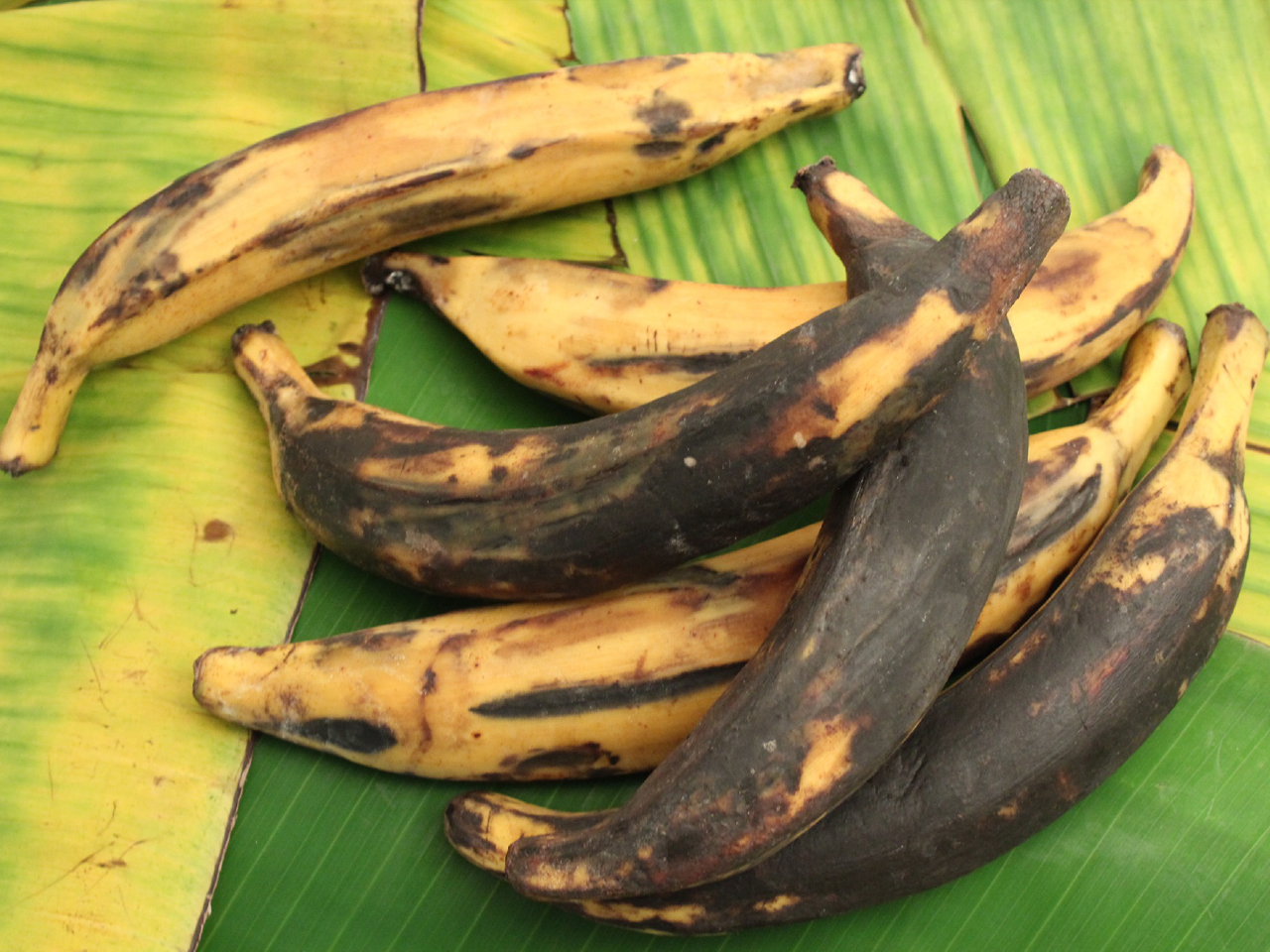
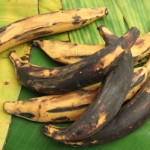
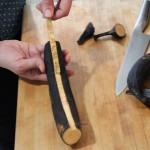
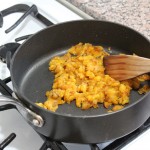
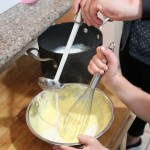

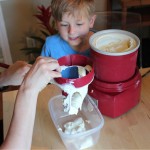
Hi Monti! What a cool website! I was born in Chicago but moved to Puerto Rico when I was 12 with my Puerto Rican parents and four brothers. Married an Irish American guy there… go figured, and have lived now in different states. Currently Portland, Oregon. I too enjoy cooking. I sometimes make meals to go for busy moms. Keep up the good work! Lots of love to Danger!
Thank you for sharing your recipes.
Hi Nancy! I lived in Seattle for a few years. Love the northwest! Thanks for checking out the site. Hope it brings you back to the island. Lots of love!
Love it!! I was like you Spanish a mess can’t dance either and hadn’t visited PR in years but once my kids got old enough to understand I decided to take them back to the island and show them what Aguadilla Puerto Rico is all about. The beaches, the Palm trees, the culture and most importantly what a mess out family is but how much love resides within our Puerto Rican family. My wife who is Mexican absolutely loves Puerto Rico, the food and that sense of family. We now do the trip every year going on 3yrs now and we all look forward to being there enjoying Puerto Rico. You seem like you are a super busy person but you have to take time to relax and show your son the beauty in being Puerto Rican by making the trip back home. I hope to see you make the trip and incorporate thy trip and family cooking into this website with pictures, stories and your soundtrack of the experience. Keep ’em coming cause I’ll keep reading, Boricua. Say Weeeepa!!!!
We’re trying to make it back this year for Christmas. Fingers crossed!
Did you give up on this site. Haven’t seen you post anything in quite a while. 2 months or so. Anyways just checking. I loved the site and concept. Hopefully you find time to get back to it. I can imagine it my be time consuming and you are a busy woman. Hope to see updates soon.
Monty! I’m actually working on a couple of new recipes this week. The site has been temporarily put on the back burner so I could focus on some pretty big projects. Can’t wai til I can share them with you! New content on the way. PROMISE!